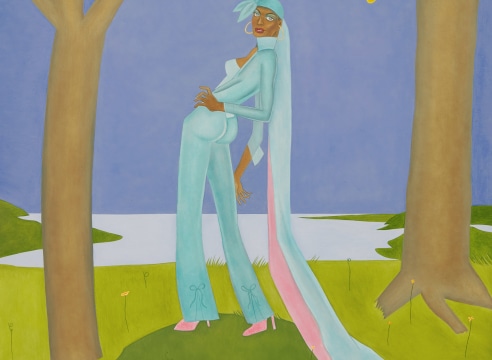
Construct is built around the theme of social and material construction. The artists included use painting, sculpture, printmaking and collage to examine construction through various media. Whether through repurposing imagery or materials, creating imagined scenarios, shifting a ubiquitous object, or abstracting a familiar scene, each artist is restructuring information as we usually experience it to create a new paradigm for viewing our everyday physical and societal structures.
The exhibition will show Left-Twist Blocks, a new work by Aaron T Stephan. At first glance these may not seem different from the universal cinderblock, however Stephan has cast cinderblocks in a torqued form. These twisted blocks, which in stacks spiral upwards, lack functionality of the original form, turning ubiquity into the monumental.
Also working with concrete is Stephanie Cardon. Her piece Oil and Water uses fabricated cinderblocks and suspended bamboo thread to create a dimensional moiré effect in space. Her cyanotypes, Lazy Haze and Seersucker Sky, create a similar moiré pattern, showing shifting perceptual qualities. The choice of process resulted from a curiosity about how the space or distance between things could be represented. These works show an exploration of an idea from two angles, allowing the viewer insight into Cardon’s process.
Margaret Rizzio’s collages, Sardines and Adventure is Here use ephemera such as books, magazines, playing cards, advertisements, and stamps from the 1940’s-60’s as source material. Focusing in on representations from this specific time period, she recontextualized the imagery, creating a warped nostalgic commentary on the world today.
Representing a different facet of the theme are paintings by Elizabeth Fox. Look at what the Venus blew in and Help in Wonderland are paintings of imagined scenarios, playing with situations in a way that is seemingly dismissible as reality.
Fox’s paintings pose questions as to who or what is the dominant power, showing pivotal moments from a humorous angle and calling into question construction of our societal structures.
Cal Siegel’s work Mega Gem combines wood, plaster, resin, and salt in a collage of materials. The frame structure brings up ideas of architecture and archaeology, simultaneously growing and deteriorating. Untitled presents a combination of materials with specific histories. The found wood was once a piece of a loom from the 1800’s. Plaster and acrylic paint distort this history, creating an enigmatic object.
Cloud Sea Fog Steam Sky is part of a recent interest of Cig Harvey’s in presenting pieces of written text in neon. This phrase comes from writing that Harvey did describing the feeling of the world being upside down. The words are disorienting in combination, but when placed in this specific order and material, function to reorient and generate an imagined scene as much as they perplex.
John Goodyear creates a new way of seeing through playing with perceptual qualities, pushing the viewer to experience a new reality. Red, Yellow, Blue Construction abstracts simple forms and colors into an optimal discovery.
In Interior, Fairfield Porter (1907-1975) uses flat, opaque colors to create a distinct three-dimensional space. These abstract forms piece together just enough information of the situation to draw the viewer in, only to remind them that they are on the outside looking in. Porter’s work Isle au Haut uses subtle tonal variations to piece together an image of the scenic Maine landscape. His colors portray the seaside cliffs as serene and stoic.